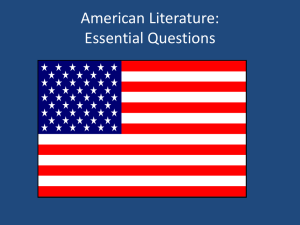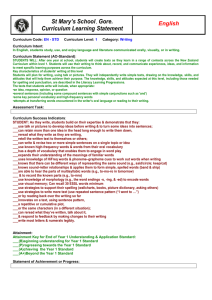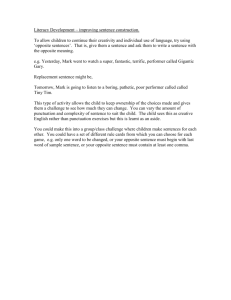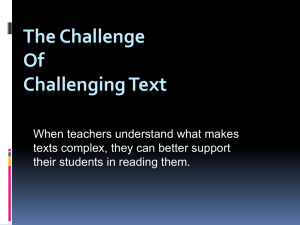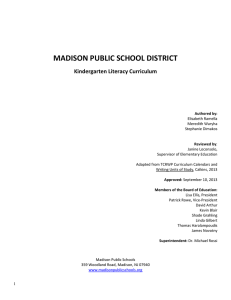How to get an A - Language tips - BEW
advertisement
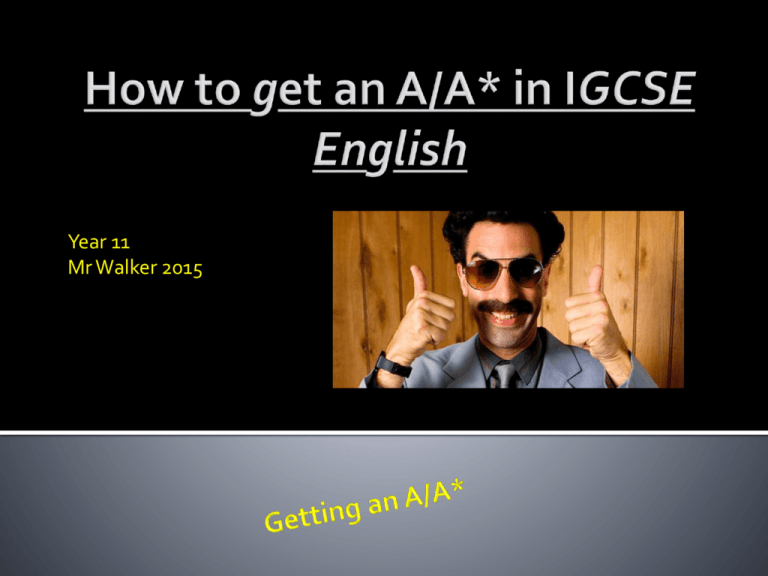
Year 11 Mr Walker 2015 Where a question is seeking retrieval, students are expected to locate the necessary detail and do not have to make an interpretation. Where students are required to infer, they will need to go beyond retrieval and will need to interpret how details tell us more. Where questions ask specifically about language or presentation features, students will have to select details that support the writer’s intention and be able to explain their effect. Comparison questions will expect students to consider what is the same or different about the writers’ intentions and to select evidence that supports their interpretation. At C grade, students will show that they understand a text and can sometimes comment on language choices and how these meet the writer’s intention. An A/A* response will be an informed, critical response to the text and the language devices used to appeal to a particular readership. They will offer their own interpretation of the writer’s ideas, selecting supporting detail imaginatively. At B and C, indicators of achievement is explanation that leads to exploration. At A and A*, examiners are looking for perceptive, sustained and sophisticated analysis; a real ownership and control of the analysis. Read a range of newspapers at home: identify PAT, (Purpose, Audience, Tone) highlight the techniques, facts, opinions, layout and presentation used etc. www.bbc.co.uk/news Look at the number of marks and plan out your response accordingly (DON’T WASTE TIME OVERPLANNING – you know who I’m talking to Year 11 students!!) Use mnemonics to remember techniques: AFOREST (alliteration, fact, opinion, rhetorical question, emotive language, statistic, triplet/rule of three etc.) Practise writing paragraphs on authors’ use of language; presentational devices; fact and opinion... Past papers (available from the website http://year11englishrevisioncafe.yolasite.com/) Demonstrate reading skills We become better readers simply by reading more… both fiction (teachers and school library are happy to recommend) and non-fiction (e.g. newspapers, magazines, leaflets, cornflake packets) Struggling readers find it difficult to decode texts. Competent readers understand texts they can identify the “what” of reading). High-level readers can respond to implied meanings and hints; distinguish between fact and opinion; follow and comment upon an argument; and comment on writers’ style and use of language (this is the “how” of reading) A/A* Grade – Word Level Lively, often unexpected, but not over-elaborate Well-chosen verbs, rather than heavy use of adverbs Confident use of abstract nouns, when appropriate Not excessive use of modification Correctly spelt Aberration abhor acquiesce alacrity amiable appease arcane avarice brazen brusque cajole callous candour chide circumspect clandestine coerce coherent complacency confidant connive cumulative cynical debase decry deferential demure deride despot diligent elated eloquent embezzle empathy enmity erudite extol fabricate feral forsake fractious furtive gluttony gratuitous haughty hypocrisy impeccable impertinent implacable implicit impudent incisive indolent inept infamy inhibit innate insatiable insular intrepid inveterate jubilant lithe lurid maverick maxim meticulous modicum morose myriad nadir nominal novice nuance oblivious obsequious obtuse panacea parody penchant perusal plethora predilection quaint rash refurbish repudiate rife salient serendipity staid superfluous sycophant taciturn truculent umbrage venerable vociferous wanton zenith Ludwig Wittgenstein, philosopher, suggests that language helps us to express what we notice. 1) A* writers are fluent, assured, confident and often quirky. They take risks in their writing. 2) Most importantly, A* writers use a variety of simple and complex sentences. Sentence variety is the key. They may start a paragraph with a short, simple sentence. They may use some sentences which coordinate ideas with “and”, “but” or “or”. They will also use complex sentences. But the key is variety – no single style dominates. 3) A* writers use vocabulary which is descriptive (but not too flowery), precise, visual and occasionally unexpected. They use simple, familiar words as well as more complex ones. Their writing helps us to see what they are describing or to understand the ideas they are explaining This is A* writing: Describe the room you are in. This room is prisonlike. It feels somehow as if I am trapped here, imprisoned, even though the window is open, the door ajar, and a breeze drifts in from outside. All the same it is a prison, a place where I am locked each evening until I’ve completed my homework. It ought to be a private place of enjoyable study; instead, sadly, with the exams looming, it’s a place I loathe. (= variety of sentences, variety of vocabulary) This isn’t A* writing: Describe the room you are in. The room is small and like a prison. I feel as if I am trapped here because of all the work I have to do before the exams. A window and door are open and there is a soft breeze but it still feels to me like a prison cell. (= lack of variety of sentences and predictable vocabulary) 1) 2) 3) 4) 5) 6) 7) 8) Start with descriptive detail Use eye-catching similes/metaphors Use vivid but not over-the-top vocabulary Play around with point-of-view Use sentence variety (short & long) Start some sentences with a phrase Use a mix of statements, questions, dialogue, statistics, quotations: Show that you understand how punctuation works Always plan your response (by paragraphs to ensure you use them) Spend less time on the first writing task than on the second Always proof read your work: check for spelling, capital letters and punctuation. Who is your target audience? Make sure your writing suits them. Avoid slang and ‘ordinary’ vocabulary. Practise writing timed responses so that you can work under pressure. Text-level Confident appropriate tone Formal and informal styles, as appropriate Understanding of genre (eg newspapers, ghost stories) Clearly organised – eg layout, and sophisticated discourse markers (eg however, although, despite this) Sentence-level Variety of sentence types Short sentences used more than in C and F work Confident punctuation to assist the reader’s understanding – esp parenthetical commas, colons, semi-colons. No use of the comma splice Word-level Lively, often unexpected, but not over-elaborate Well-chosen verbs, rather than heavy use of adverbs Confident use of abstract nouns, when appropriate Not excessive use of modification Correctly spelt This is the part of the exam paper that students most often find difficult Language of the exam question Writing on what is not being asked for Mistakenly believing that the examiner wants their opinion on the extracts Read the questions carefully and ignore any irrelevant information. Look at the number of marks designated to the question and divide your time accordingly. Use the exam texts: highlight, underline, circle... Use the language of the exam question. Read the texts more than once.


